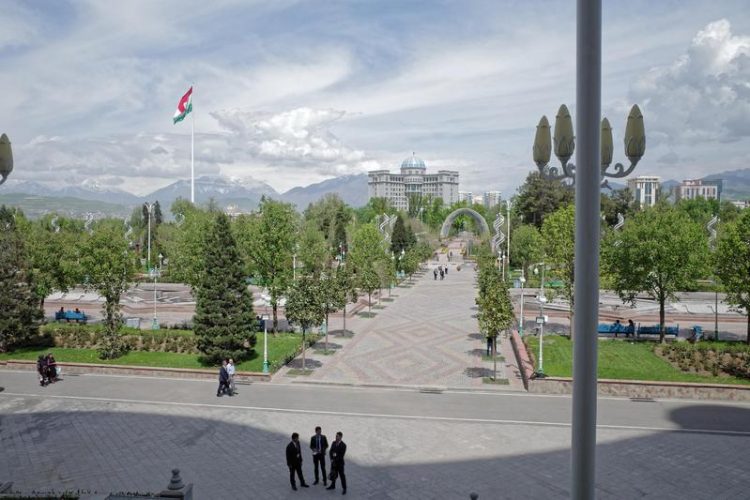First dust conference in the Central Asian part of the earth’s dust belt

Dushanbe: German-Tajik research cooperation set impulses CADUC/TROPOS
These dry regions extend from the Sahara in western Africa to the Middle East and the deserts of China. Millions of people in these regions suffer from the effects of dust on their health, flora, economy and climate.
Nevertheless, for a long time the western Central Asia was an almost white spot in the global dust observations, atmospheric modelling and research until the first TROPOS laser measurements began five years ago in the Central Asian Republic of Tajikistan.
Since then, German-Tajik cooperation has developed very successfully and inspired many researchers. Experts from Asia, Europe and America participated at the dust conference.
In total, dust particles with a mass of about 1500 megatons enter the atmosphere every year. The Sahara is thought to be the main source with about 1000 megatons. So far it can only be speculated how much the deserts and steppes of Central Asia contribute to the total amount of mineral dust in the atmosphere, because for a long time there was a lack of measurements in this important region of the dust belt.
How long dust floats in the air varies and depends on regional weather conditions and particle size. Large particles have a shorter residence time than small and therefore lighter particles, which can quickly reach great heights in updrafts. On average, dust particles remain in the atmosphere for one to two weeks and spread with the wind.
Mineral dust plays a major role in the global climate because the dust particles floating in the atmosphere reflect sunlight and dim the sun's rays arriving on the ground. In addition to this direct effect, there is also a so-called indirect aerosol effect: the particles act as cloud germs and influence cloud formation, which also has an effect on the Earth's radiation budget and can cool or warm depending on the type and height of the cloud.
In addition, there are many other effects whose significance has only slowly been understood in recent years: Chemical reactions can take place on the surface of the dust. Trace metals in mineral dust fertilize the ocean and drive many biogeochemical processes in the ocean.
Heavy dust outbursts can affect the local infrastructure, such as photovoltaic systems. In addition, there are the effects on people's health, some of whom suffer from severe dust storms: Dust has a negative effect on the respiratory tract and can also transport bacteria and diseases.
The content and origin of the contributions at the Central Asian DUst Conference (CADUC) in Dushanbe were as complex as the effects of dust on the climate, infrastructure and health. They range from dust sources, transport routes and dust sinks to a wide variety of effects. In the Sources section, for example, satellite images are used to discuss various deserts and steppes in Central Asia as dust sources, an outbreak in the Mongolian Gobi Desert was analysed, the contribution of dust from drying lakes was examined, an overview of salt lakes was given or sandstorms in the Arab region were evaluated.
In the field of transport, contributions dealt with laser and satellite observations in East Asia, lidar measurements in Tajikistan, computer models for Central Asia, the transport of dust from Iraq and the Arabian Peninsula to Iran, and the effects of the almost dried up Aral Sea, whose dust can be transported as far as Moscow.
With regard to dust sinks, the researchers wanted to discuss models for dust transport in the Caucasus and the Aral Sea region as well as analyses of the chemical composition of dust from Western Siberia, Uzbekistan and Tajikistan, among others. The conference contributions on the effects of dust were also extensive: They range from the effects on cloud formation to consequences for the growth of trees and dust as a means of transport for bacteria. For example, a research team from Hungary was able to identify exotic bacteria in the dust of Budapest. Tilo Arnhold
Links:
Central Asian DUst Conference (CADUC), 8 – 12 April 2019:
https://www.tropos.de/CADUC
The Abstracts will be open access later here: https://www.e3s-conferences.org/
CADEX – Central Asian Dust Experiment:
https://www.tropos.de/en/research/projects-infrastructures-technology/research-p…
&
https://www.tropos.de/aktuelles/messkampagnen/blogs-und-berichte/cadex-2014-2016…
Leipziger Staubtag:
https://www.tropos.de/en/current-issues/events-and-lectures/leipziger-staubtag/
Contacts:
Prof. Dr. Sabur Abdullaev,
Lab. of Physical Atmosphere, S. U. Umarov Physical – Technical Institute of the Academy of Sciences of the Republic of Tajikistan, Ayni str.299/1, Dushanbe, Tajikistan, ZIP-734063
https://www.tropos.de/fileadmin/user_upload/Institut/Abteilungen/Fernerkundung/D…
and
Dr. Dietrich Althausen (reachable by phone from 16.04.19, before only via email),
Leibniz Institute for Tropospheric Research (TROPOS), Permoser Str. 15, 04318 Leipzig, Germany
https://www.tropos.de/institut/ueber-uns/mitarbeitende/dietrich-althausen/
as well
Julian Hofer (reachable by phone from 16.04.19, before only via email),
Leibniz Institute for Tropospheric Research (TROPOS), Permoser Str. 15, 04318 Leipzig, Germany
https://www.tropos.de/institut/ueber-uns/mitarbeitende/julian-hofer/
or
Tilo Arnhold
TROPOS Public Relation
Tel. +49-341-2717-7189
https://www.tropos.de/en/current-issues/press-releases/
Originalpublikation:
Ansmann, A., Mamouri, R.-E., Hofer, J., Baars, H., Althausen, D., and Abdullaev, S. F.: Dust mass, CCN, and INP profiling with polarization lidar: Updated POLIPHON conversion factors from global AERONET analysis, Atmos. Meas. Tech. Discuss., https://doi.org/10.5194/amt-2019-98 , in review, 2019.
https://www.tropos.de/en/current-issues/press-releases/details/translate-to-engl…
Media Contact
All latest news from the category: Event News
Newest articles

First-of-its-kind study uses remote sensing to monitor plastic debris in rivers and lakes
Remote sensing creates a cost-effective solution to monitoring plastic pollution. A first-of-its-kind study from researchers at the University of Minnesota Twin Cities shows how remote sensing can help monitor and…

Laser-based artificial neuron mimics nerve cell functions at lightning speed
With a processing speed a billion times faster than nature, chip-based laser neuron could help advance AI tasks such as pattern recognition and sequence prediction. Researchers have developed a laser-based…

Optimising the processing of plastic waste
Just one look in the yellow bin reveals a colourful jumble of different types of plastic. However, the purer and more uniform plastic waste is, the easier it is to…



